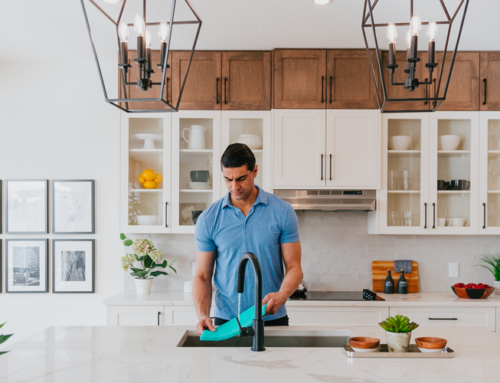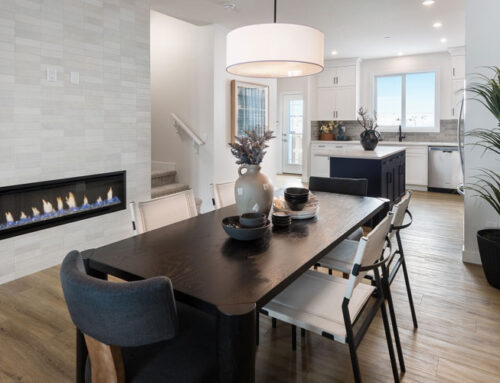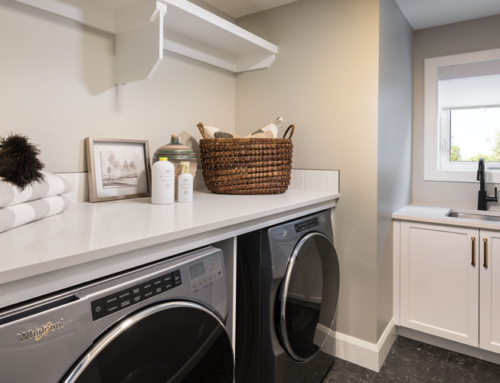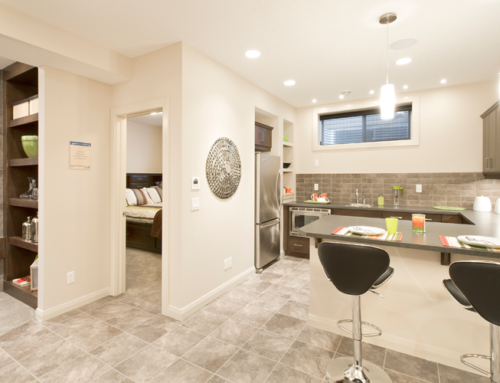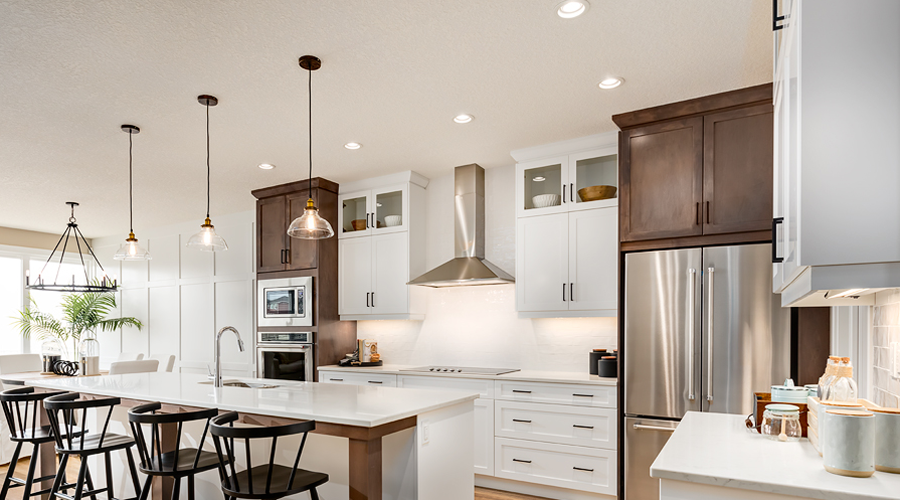
Lighting is an essential component to a well-functioning home and a successful design scheme. Without it, you’re just sitting in the dark. Great lighting, and even worse poor lighting, plays an important role in creating a healthy, safe home environment, as well as impacting how everything else in your home from the art on your walls to your rug looks.
Essential lighting allows you to move around your home and perform functions like food preparation and personal grooming. Its necessity is undeniable in winter when the days are shorter, and we spend more time indoors. But that’s not all it can do.
Think about all the ways light not only allows you to see clearly and illuminate the whole room but also sets the mood and affects how you feel. Lighting can guide your eye around a room by providing a focal point, highlighting architectural features, and changing a room’s atmosphere and warmth. Today’s lighting has little to no resemblance to homes pre-dating the 1970s with only one central light fixture in each room.
One of the most important trends for anyone building a new home to consider is lighting that is more integrated, which is best done before your home is built. That’s why lighting should be an important part of any new home plan.
Plan ahead
To make your space brighter and more beautiful, it’s essential to plan your lighting design early and consider all the sources of light you’ll need. The overall goal for home lighting is that it should be comfortable, easily controlled, and energy-efficient.
Whether it’s a wall sconce over a chair for reading or eye-catching ceiling light, the right wiring, and electrical outlets need to be planned in advance.
Be sure to take the time to look over the layout and the electrical plan (aka electrical drawings or wiring diagram) for each room. It’s easy to move, add more, and adjust the plan at this stage of the building process. Retrofitting or renovating later is a lot more difficult and expensive.
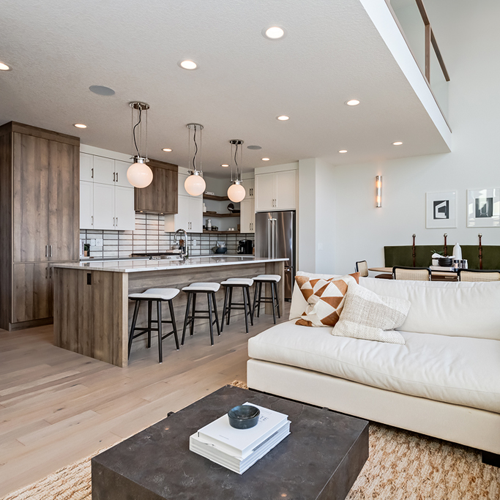
Mix it Up
One of the most common lighting mistakes people make is expecting one type of lighting to do it all. A good lighting plan will use all three layers of lighting. Ideally, each room will include all of them.
The three main types of indoor lighting to consider are:
- Ambient (also called general lighting) fills most of the room with uniform light and allows you to move around safely. It is usually controlled by a light switch and comes from ceiling-mounted or recessed fixtures that direct light downward; cove, soffit, and valance lighting that bounces light off ceilings and walls; or wall-mounted fixtures like wall sconces or floor-lamps that wash the walls with light.
- Task lighting is targeted light directed to a particular area of the room to assist you in completing a particular function. This could be kitchen under-cabinet lighting for food prep on a countertop; a table or desk lamp for reading; or pendant lights that hang over a kitchen island for dining.
- Accent (also called highlighting) draws attention to a particular focal point such as artwork or bookcases. Often track lighting, wall-mounted fixtures, or picture lights are used to precisely focus on an object.
The best way to plan most rooms is to consider the ambient lighting first, then task and accent lighting. Task-orientated rooms, like home offices, may benefit by focusing on task lighting first. A time when accent lighting might be the first consideration is a hallway that doubles as an art gallery.
Types of lighting fixtures
Simple table lamps that just need to be plugged in won’t require a lot of pre-planning unless they’re in the middle of the room. But any integrated lighting choices and certain types of fixtures will need to be added to your home’s electrical plan from the start.
Here are some of your choices for lighting that’s built into your home:
- Ceiling-mounted lights are a type of fixture fixed directly to the ceiling with a glass or plastic shade concealing the light bulb. They’ve been a mainstay in homes for nearly a hundred years.
- Recessed lighting directs a narrow band of light in one direction is installed above the ceiling with an opening that is flush with the ceiling. It requires at least 6 inches of clearance and insulation to avoid condensation dripping into the fixture. The most common recessed lighting is pot lights.
- Architectural lighting, such as cove, soffit, and valance, provide an even distribution of lighting while concealing the source in the room’s structure like a ledge, cornice, or horizontal shield. They’re located high up in a room and bounce light off ceilings and walls to create indirect lighting. It’s an ideal way to light up the corners, minimize shadows and glare.
- Wall-mounted lighting, like sconces, are fixtures surface-mounted to the wall and depending on the fixture direct light upwards, downwards, or are adjustable.
- Track lighting can be either mounted or suspended from the ceiling. It will have a number of heads that can be positioned anywhere along a track with an adjustable head to direct the light.
- Undercabinet lighting is extremely popular and mounted under kitchen cabinets.
- Pendant lights or chandeliers are suspended from the ceiling and direct light down. Depending on how far they hang down, care needs to be taken to ensure they’re positioned in the right place over a table or island where people won’t bump their heads. Often decorative in style, they are an opportunity to make a statement in a room.
- LED-integrated lighting (also called luminaires) is a type of fixture that doesn’t require a separate LED bulb or tube because it is already part of the fixture. They’re a popular choice and may allow for increased light control, but also come with a few maintenance and upgrades challenges.
While there are endless possibilities and fixtures to choose from, especially when you’re starting from scratch, interior designers advise clients to choose a theme, colour scheme, and material finish first. Too many styles will be confusing to the eye. Keep it simple and consistent throughout your home to create beautiful, comfortable spaces.
Helpful lighting with dimmable fixtures
A simple change that will enhance your lighting is to put dimmers on all your lights. Dimmers allow you to change the brightness of a bulb, which creates all kinds of opportunities.
The advantage of a dimmer over an on-off switch is that it helps save energy, cuts glare, and provides flexibility. Dimming a light down just 10 percent will double the life of your light bulb and provide energy efficiency. Dimmers also allow you to manually adjust your lighting to respond to changes in natural light and seasons. And when you take all your lights down, you can create a totally different mood.
Choose the bulb carefully
If you’re ready to take your lighting to the next level, ask about new lighting options and be choosy about your bulbs. Lighting technology is evolving rapidly with more options than ever for homeowners.
An ongoing trend towards energy efficiency has led to a big push away from incandescent bulbs, which waste power in the form of heat. More homeowners have switched to LEDs for their power-saving properties and longevity, which can easily be integrated into your home through all types of fixtures and built-in lighting to create light for many purposes.
Smart bulbs allow for increased functionality, and often with the ability to control it through a phone app. One of the biggest advantages of smart lighting is the ability to adjust the colour temperature vs. pre-selecting only one for regular bulbs. This allows people to adjust the light throughout the day and for different uses especially in rooms with multiple uses. Start with bright, cool white light to stay focused and alert. Dim and warm the light at dinnertime. And then warm your lights to mimic the light at sunset to help you wind down in the evening.
The right lighting in each of your rooms is not only helpful but can draw people in and light the way at night.

